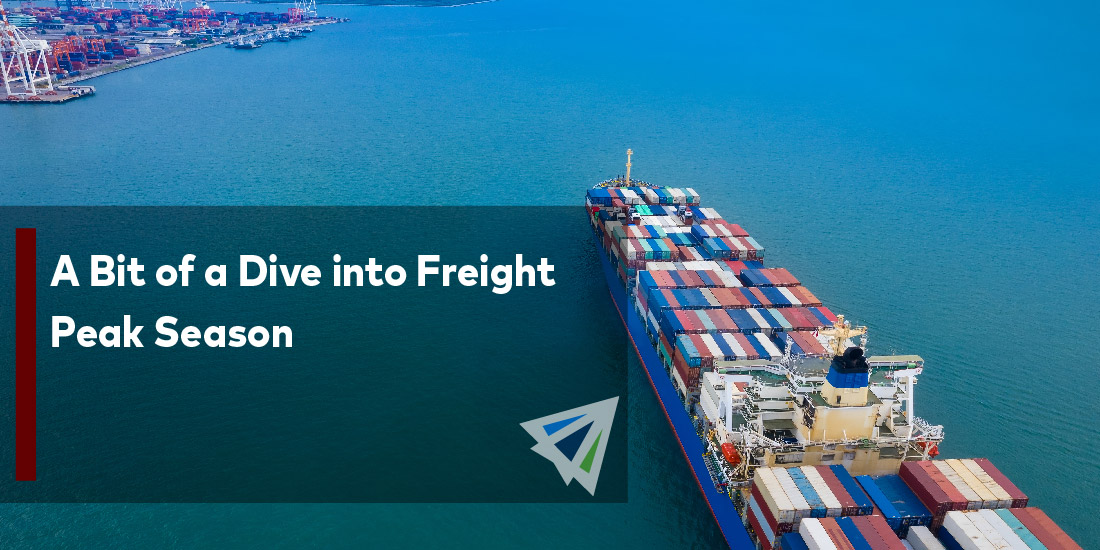A Bit of a Dive into Freight Peak Season
Peak season is always one of the most stressful seasons for shippers around the world. Equipment tightens, rates go up, and volatility in rates, vessel availability, and delivery times skyrockets. It’s a stressful season full of uncertainty, and the several months leading up to it are generally spent planning and strategizing the best way to navigate it.
If the uncertainty and volatility of freight peak season wasn’t already enough, this year is beginning to look even less predictable. Truthfully, no one has a “best guess” as to how things are going to go. According to industry and economic experts, there’s roughly a one-third chance of an economic recession that could hit later this year which would have a direct impact on the peak season.
The Uncertainty of Freight Peak Season
This spring, inflation hit 8.5 percent which has put fiscal pressures on sellers, 3PLs, freight forwarders, and manufacturers. The Federal Reserve has attempted to combat issues related to inflation increasing by introducing interest rate hikes that are meant to curb inflation and restore some balance to the economy. However, at this point in time it’s still unclear whether or not these measures will prove effective come the end of the year.
Here’s what this all means: The place that shippers are left to make important business-related decisions is one of complete uncertainty regarding the potential rise or fall of demand among U.S. consumers.
Anyone who has been paying attention to the global supply chain and eCommerce activity over the last year knows that producers are struggling to keep up with current demand. Supply chain issues mean that shipments are moving slower and it’s difficult for U.S. producers to get their hands on foreign-sourced components and parts. This is all hitting alongside one of the biggest rises in U.S. consumer demand which puts additional pressure on the shipping and manufacturing industry.
Making Market Based Decisions
When planning for peak season, shippers are making major financial decisions to overstock inventory on the basis of trends happening currently in the market. Demand is high which would generally lead shippers to import more than enough inventory to satisfy current and increasing demand levels. However, with the risk of a potential recession, the next few months could introduce a major bite-down on U.S. buyer demand. This puts U.S. importers at risk of overstocking inventory they can’t sell, which would push the economy into a further recession as the spread between supply and demand would increase significantly after freight peak season.
The Southern Californian ports of Los Angeles and Long Beach are already reporting an overall downturn in port activity since May 2021. While imports and port activity had climbed to record levels through the spring, activity is beginning to plateau and, in some cases, drop below what it was at the same time last year. Since May 2021, at the port of Long Beach, imports have dropped by nearly 2 percent, and exports by a whopping 12 percent.
Additional chaos is introduced into the mix regarding imports coming from Asia. As the pandemic shutdowns and severe regulations in Shanghai and Shenzhen are lifted, a major influx of cargo is expected to hit Southern Californian ports which would increase congestion and bog down port operations for weeks to months.
Not only are the larger market forces such as equipment shortages and global congestion causing bottlenecks in the freight industry – the local carrier market for inland transportation of containers out of ports is being severely hit as well. This last piece that’s introducing extra uncertainty and pain to the U.S. shipping market are the higher fuel costs and surcharges that are putting undue pressure on the domestic trucking industry.
These pressures are causing truckers to retire early or leave their jobs due to the unrealistic work conditions and expectations. As a result, carriers have rapidly hired additional truckers at above-average market rates, essentially pushing their businesses into debt in hopes that the increased activity will pay off in the long run. But as clarified earlier, the threat of a recession puts all carriers at risk of not making their money back on these internal and external investments.
In Summary
In summary, there’s no telling which way freight peak season will go this year. If demand continues to climb, congestion and delays will increase. If demand drops amidst a recession, businesses may face the risk of overstocking unsellable inventory, pushing them to make staffing and budget cuts, or potentially to close their doors.
If you have questions about what the market looks like right now and how it could affect your business and current shipping practices, please don’t hesitate to just reach out with questions. We’re here and happy to answer any and all questions, and to help your team in any way we can!
